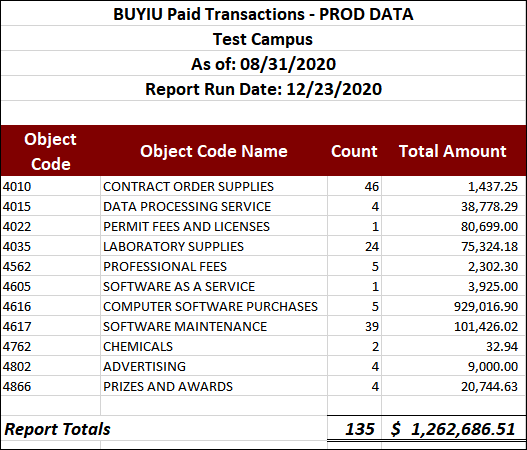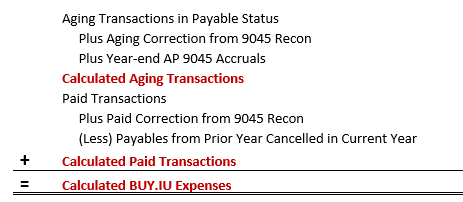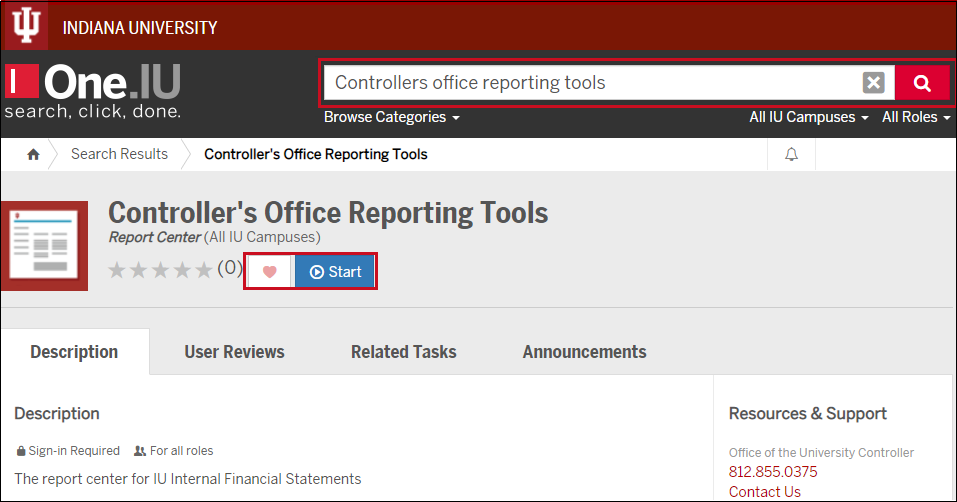Prerequisites
Prior to reading the instructions on the BUY.IU Paid Transaction report, it is beneficial to review the following sections of the IU Accounting Standards Book to gain foundational information along with report requirements and best practices:
- Accounting Fundamentals Standards Pressbook
- Chart of Accounts and General Ledger Standards Pressbook
- Income Statement Pressbook
- BUY.IU Financial Reports Instructions
- BUY.IU Aging Report Instructions
Overview
The BUY.IU Paid Transactions report shows users payments that have been issued related to their procurement transactions. Once an invoice is paid, the transaction moves off the BUY.IU Aging report and appears on the BUY.IU Paid Transactions report.
Four tabs make up the BUY.IU Paid Transactions report:
-
Paid Transactions Details: Displays all invoices paid through the date specified in the report parameters. The tab includes information such as supplier invoice number (#), invoice line item accounting detail, quantity, payment disbursement date and specific information on how the invoice was recorded.
-
Object Code Details: Provides a listing of total amounts paid by object code, including the object code name and the number of BUY.IU invoice lines associated with those object codes.

-
Paid Transaction Help: The Paid Transaction Help tab provides brief definitions of BUY.IU invoice information.
-
Report Parms: Summarizes the parameters selected on the report parameter page within the Controller’s Office Reporting Tools app, including as of date, chart code, and account information. Since BUY.IU searches retrieve real-time data, it is important to remember reports produced in the Controller’s Office Reporting Tool are one day in arrears. The reporting tool uses data stored in the DSS tables, which are updated nightly. BUY.IU Financial Reports with an as of date parameter set equal to the current date will not match BUY.IU search results for the current date.
How the BUY.IU Paid Transactions Report Works
In order for a transaction to appear on the BUY.IU Paid Transaction report, a check, ACH or wire payment must have been issued to the supplier. The BUY.IU Paid Transaction report total balance shows part of the general ledger balance total. To arrive at the general ledger balance (for the BUY.IU related expenses), the BUY.IU paid transaction total should be added to the BUY. IU Aging transactions in Payable status plus any discrepancies as shown in the equation below:

The BUY.IU Paid Transactions report can be accessed from this page - refer to the top right blue button labeled "Go to Report" which will automatically redirect users to the report within the Controller’s Office Reporting Tools.
In addition, the report can be found in One.IU.To find the report, search for “Controller’s Office Reporting Tools” in the search bar, and select Controller’s Office Reporting Tools (Report Center) in the drop down menu. Mark this task as a favorite by clicking the heart icon next to the start button and then select Start or click on the title.

Once in the Controller’s Office Reporting Tools, users will see all available reporting tiles. Navigate to the Expense, Encumbrance & Payments folder. A new tile opens, which displays all the available reports. Select the BUY.IU Paid Transactions report.

Running the Report
Define the search parameters to return results relevant to your organization or to a specific account. The search parameters available in the BUY.IU Paid Transactions report are divided into three parameter types: Chart of Account report parameters, Report Specific parameters and Display parameters.
If there are questions related to running the report, requirements or reviewing results, please contact your (RC) fiscal officer or campus office. Each campus may have individual specific requirements related to BUY.IU Paid Transactions report, be sure to reach out to the related campus office or fiscal officer prior to quarter closings.
General Notes: Do not include any special characters other than approved wildcards in any of the below parameters. Additionally, do not run reports by campus as it will take up valuable computing services.
Several parameters are available to assist users. Users can enter the responsibility center (RC) code, organization code, and account number(s) for their respective organization. In order to prevent long run times, users are required to enter at least one Chart of Accounts Parameter in conjunction with any other parameter, i.e. As of Date and Organization Code or Account Number and BUY.IU Invoice Number.
If unsure, several of the parameters have a valid values function which displays the available codes and corresponding descriptions.
| Parameter | Description |
|---|---|
| As of Date | Used to limit report to a specific fiscal year(s). |
| Chart Code | Used to limit report to one or more specific chart of accounts. For assistance determining your chart code, refer to KFS Chart Search. |
| Responsibility Center Code | Used to limit to a specific RC. Users are encouraged to use this parameter in conjunction with a chart of accounts code. For assistance determining your RC code, refer to KFS RC Search. |
| Organization Code | Used to limit report to a specific organization code. Users are encouraged to use this parameter in conjunction with a chart code. At this time, Buy.IU is not configured to allow organizational hierarchy reporting. For example, if the user entered BA-RPAS the report would not return any results. In order to see all of the data for BA-RPAS, the user would need to enter all of the individual organizations. However, a user can save the parameter set (with all of the individual organizations) for the next time they need to run the report to avoid having to rekey them each time. |
| Account Number | Used to limit report to one or more specific account(s). |
| Sub-Account Number | Used to limit report to one or more specific sub-account(s). |
| Object Code | Used to limit report to specific financial object code(s). |
| Fund Group | Used to limit report to specific financial object code(s). |
| Sub-Fund Group | Limits report to one or more specific sub-fund group(s). |
A report specific parameter is a parameter that is limited to a single or small group of reports. For example, on the BUY.IU Paid Transactions report users would expect to see a parameter to isolate the report data by BUY.IU Invoice Number, but that is not likely to be applicable on the majority of other reports.
| Parameter | Description |
|---|---|
| BUY.IU Supplier Number | User can narrow report output to view by a specific supplier in BUY.IU by entering a single supplier number. |
| BUY.IU Invoice Number | By entering a single BUY.IU Invoice Number, the user would be able to identify the invoice type and the invoice status. Note: If the invoice has been paid, it will not appear on the BUY.IU Aging Report. |
Display parameters are parameters that define and restrict the visual presentation of the BUY.IU Paid Transactions report. They are found on the lower part of the parameters.
| Parameter | Description |
|---|---|
| Report Style | The report style parameter is used to limit level of detail required in the reports: 1. Consolidated – presents financial information in a consolidated format for the display level requested i.e. organization or account. 2. Detail by Account – higher level of detail showing the different accounts separately. 3. Detail by Account and Sub-Account – Highest level of detail showing different sub accounts within an organization or account separately. Note: users are not able to select detailed levels if the org hierarchy box has been checked – see chart of accounts report parameters above for more detail. |
| Include Subtotals | Check/Uncheck - If the user checks include subtotaling, the report will insert a subtotal at the account level. |
| Include Hyperlinks in Excel Output | Check/Uncheck – If the user checks include hyperlinks in excel output, the report will include links within the excel version and the user will have the ability to drill down for additional detail. Note: When using this parameter, user may need to click the “Enable Editing” button in the Excel report output in order to display dollar amounts. |
Click Save Parameter Settings to save your parameters for future use of this report. For instructions on how to save settings, review the Save Parameter Settings document on the Controller’s Office Reporting Tools page.